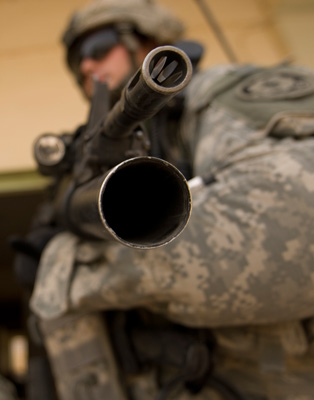Return from Iraq
Ventura County Star's Scott Hadly Recalls His Military Embed

As the world has watched the Iraq War drama unfold over the past five years, public interest has dwindled. So too has the number of reporters covering the people whose lives are affected by war. In fact, the number of embedded reporters in Iraq has gone from more than 600 at the war’s outset to less than a dozen as of the end of July. With large newspapers sending fewer and fewer reporters to the Middle East, it is almost unheard of for a local paper to do so, but Ventura County Star reporter Scott Hadly just spent July embedded with U.S. troops in Iraq.
The life of a reporter at a local paper usually revolves around attending City Council meetings, keeping in touch with community groups, and generally getting a feel for the pulse of the town in which the paper is based. Such is normally the case for Hadly, who covers the military, transportation, and development issues for the daily and who formerly worked as an investigative reporter for the Santa Barbara News-Press. But this summer’s month in Iraq with freelance photographer James Lee changed all that, if only for a short time. “If you look past all the guns slung over people’s shoulders, the big armored personnel carriers, Humvees, and Blackhawk helicopters, you can almost forget there’s a war going on,” wrote Hadly in an email to a coworker. “On the big bases in Iraq there’s a certain normalcy that makes you forget there are still people fighting and dying here, but you get reminded real quick.”
Having never served in the military himself, the 44-year-old Hadly remembers well his father’s deployments to Vietnam when he was a child and had an opportunity to see what it was like to be the one going away from his family. “I have a wife and two kids,” he said. “Every risk I’d take would make me think about that. I wasn’t taking a lot of the big risks that a lot of journalists do – going out looking for a firefight or an adrenaline rush – but there were risks.” Hadly went out on patrols with soldiers from time to time, and even went to an Iraqi funeral, but he said a lot of the safety precautions were just common sense. “You’d never walk across the street without a flak jacket.”
The experience in Iraq opened his eyes to myriad issues, from the family problems experienced by soldiers, sailors, marines, and airmen having to serve multiple tours, to the tenuous political situation in Iraq, to the challenges faced by the individuals whose country has been destroyed by war. “It would be presumptuous to go over there and say, ‘This is the situation in Iraq.’ What you’re really looking at are all these people.”
It may surprise some, perhaps, that Hadly said that being there did not make it any easier for him to understand the big picture in Iraq. But the dynamic between different kinds of people living life there was illuminating. “I think it’s a shame that we don’t do more stories about [military personnel], because they’re doing this in our name. There’s definitely some ugly stuff going on, but there are a lot of positive things, too. The downside about [embedding] is that it’s difficult to make contact with Iraqis who aren’t connected to the Americans.”
Hadly and Lee – a Marine Corps veteran who has not only served in Iraq, but also was embedded for five months with military units in Iraq and Afghanistan as a photojournalist earlier this year – originally connected with Seabees from the Port Hueneme-based Naval Mobile Construction Battalion 3 (NMCB3) in Iraq’s Anbar province. Toward the end of the month, the two linked up with the U.S. Army 2nd Stryker Cavalry Regiment from Washington. Those soldiers were based in the Diyala province, which Hadly said is considered to be one of the worst ones right now. “They would go into these palm groves and do sweeps and ambushes,” he said. “In Diyala, [insurgents] were doing ethnic cleansing. We saw deserted towns, and part of the American military’s humanitarian mission was to relocate refugees back to their villages. Iraq is like Beirut at its worst time, mixed in with some West Bank, Chicago during the 1920s, and maybe a little South Central, too.”
Now, when the activities of deployed troops are mostly focused on security, he said the story is not as acute in terms of rush or excitement, but no less germane due to the danger that exists to stability in the region. “It’s pretty bleak,” said Hadly of civilian life in Iraq. “Sometimes you can’t tell if it’s the war or poverty that’s done this to a town, and sometimes it’s a double whammy of both.”
When asked how to better understand Iraq, Hadly replied, “Read your Bible. It’s an extension of the Holy Land, and is significant to a lot of religious groups. You wonder if it should even be one country, but the flip side is that we’re now responsible for all of that shit. I have a five-year-old and a seven-year-old, and they’re going to be dealing with this.”
News about individual military units is rare, said Hadly, noting that the decreased number of journalists has had an impact on the public’s view of the war. “The families of these units are all desperate for information.” Many of the troops deployed in the Middle East are Reservists and National Guardsmen who have already served multiple deployments. “A lot of these Reserve and National Guard Units never get covered in the media, and their families just eat it up [when they are].” When troops found out that he was from a local daily, a lot of them wanted to know why he was there. “The real question is: Why aren’t there more reporters covering it?”



